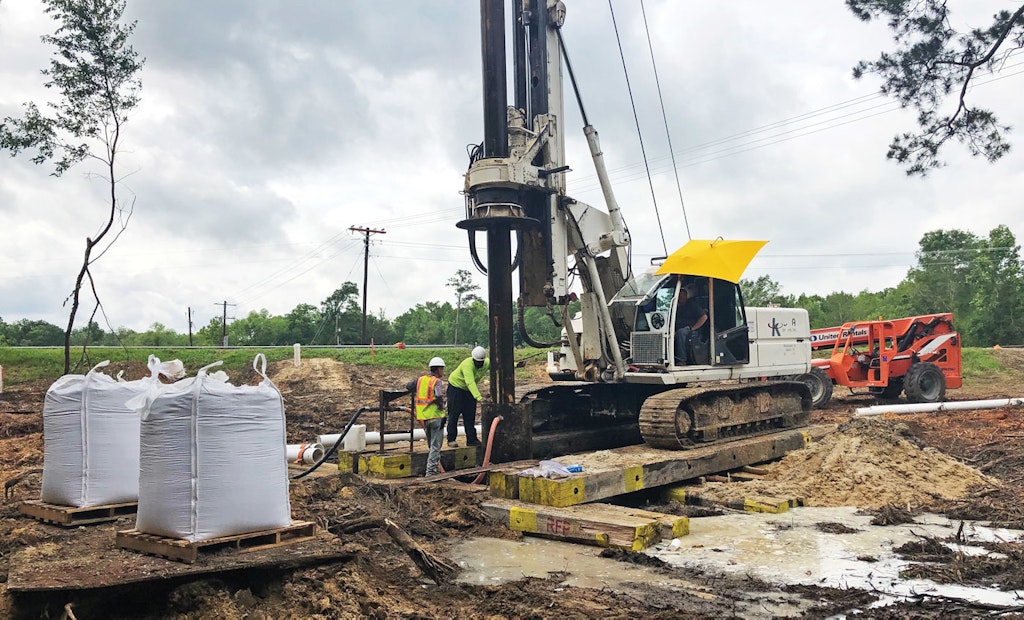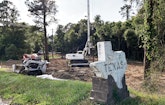
TerraFirma’s track-mounted bucket-auger drilling rig, multiple layers of massive mats, and bulk specialty well filter gravel in 3,000-pound super sacks were utilized to contend with the swampy conditions and elevated water table. (Photos courtesy of TerraFirma Earth Technologies)
Interested in Municipal/Industrial?
Get Municipal/Industrial articles, news and videos right in your inbox! Sign up now.
Municipal/Industrial + Get AlertsBefore the Sabine River Authority of Texas could launch its $75 million pipeline project in early 2016, they had to do a lot of dewatering.
The project was managed by Garney Construction, which contracted Houston-based TerraFirma Earth Technologies for the challenging job of dewatering tunnels under an open highway, active railroad and set of gas pipelines.
Garney used the construction manager at risk project delivery method, which allowed them to select the best dewatering subcontractor based on a combination of qualifications, expertise and cost.
Garney was impressed with the experience and efficiency of the TerraFirma crews. “Once on site, crews performed the work quickly to install dewatering equipment [to stay] ahead of Garney’s pipe crews and tunneling operations to maintain the project schedule,” says David Burkhart, Garney’s director of central pipe operations.
The Sabine River provides a border between Louisiana and far southeast Texas, flowing roughly 100 miles from U.S. Route 190 to the Gulf of Mexico. The area is desolate, with only two highways crossing the river: state Highway 12 and U.S. Route 190. Flowing through Newton and Orange counties, the river provides water for local industry and municipal customers. The infrastructure and location of the existing pump station, constructed in 1934, as well as changes within the river, have occasionally limited Sabine River Authority’s ability to withdraw water from the river.
During natural low flow and drought conditions, the authority has released water from the upstream Toledo Bend Reservoir to raise the level of the river at the existing pump station’s intake canal so water can be pumped. The authority received a $75 million loan from the State Water Implementation Fund for Texas program in 2016 to improve the water system by constructing an 85 mgd raw water pump station along the river, along with several miles of water conveyance pipeline to serve its customers. The new pump station and pipeline will eliminate the need to release water from the Toledo Bend Reservoir during periods when the river has low flow.
The TerraFirma crews prepared the way for the 7-mile pipeline project by dewatering the bore and jack pits at three locations using closely spaced deep well dewatering wells. The 66-inch-diameter pipeline had to be tunneled underneath the active Kansas City Southern railroad (143 feet in length), a set of active gas pipelines (110 feet in length) and Highway 12 (161 feet in length). Due to a period of very heavy rains just before construction began, as well as some rain during construction, the river rose 10 feet. That caused a subsequent rise in the water table and made the already difficult access to the various low-lying, swampy sites even more difficult. Creative solutions were in order.
The company encountered some hurdles that required special equipment and changes to the original dewatering plan. TerraFirma had to dewater the 161 linear feet from entry shaft to exit shaft beneath Highway 12 while it was in use. The authority didn’t want to disrupt traffic.
Access to the low-lying, swampy areas was the biggest challenge. It was necessary to rent special equipment to get to the site. Crews installed well groupings on each side of the crossing to surround the access shafts. The shafts had to be large enough to facilitate the massive boring machine and extended down to 20 feet deep, well below the groundwater level. First they had to dewater the shafts. Then came the job of dewatering the 66-inch-diameter water pipeline between the two shafts, which required lowering the water table from both sides of the road even farther. The traffic was unaffected, however, and drivers didn’t even know there was work being done.
Burkhart explains that Tropical Storm Imelda landed during TerraFirma’s already challenging dewatering conditions. “Their equipment, performance and installation exceeded our expectations, providing dry trench conditions in very difficult soils surrounded by swamp.”
In addition to the swamplike conditions, recent rains posed another set of challenges. Because the river’s water level was 10 feet above normal, there was a subsequent rise in the water table in the adjacent areas where crews were working. In addition to the need for mats to access the site, multiple layers of mats were required to raise the rig to an elevation that allowed the crew to drill and set the dewatering wells.
The timber mats were cabled together to form a temporary platform that workers could walk on. The machinery had to work from the mats as well due to the extremely soft ground. Additionally, larger-horsepower pumps were required to deal with the increased flow rates due to the higher than anticipated groundwater level.
TerraFirma used the bucket-auger method to install the wells, which allowed crews to drill the 30-inch-diameter boreholes to a depth of 60 feet or more. The oversized boreholes maximize the flow of groundwater to the dewatering well, ensuring the dewatering system achieved the desired results.
Still, another complication interrupted the progress of the dewatering.
“Access to the river in such a rural location with no drainage structure in place and with the rapid fluctuation of the river, presented unique circumstances,” says Chad Sharbono, project manager for Garney. “There were tight conditions TerraFirma had to get through to have access to the railroad and other tunnels. They were dewatering only about 100 feet from the rising river. Flows were changing constantly. The collaboration we achieved due to the CMAR delivery model gave everyone reason to come to agreement. We were able to see unusual risks and budget for those, avoiding possible contention. In the end, both parties were able to manage a solution.”
As of February 2020, the tunnels have been successfully installed and the dewatering wells remain in place until the water conveyance pipeline tie-ins can be made.







